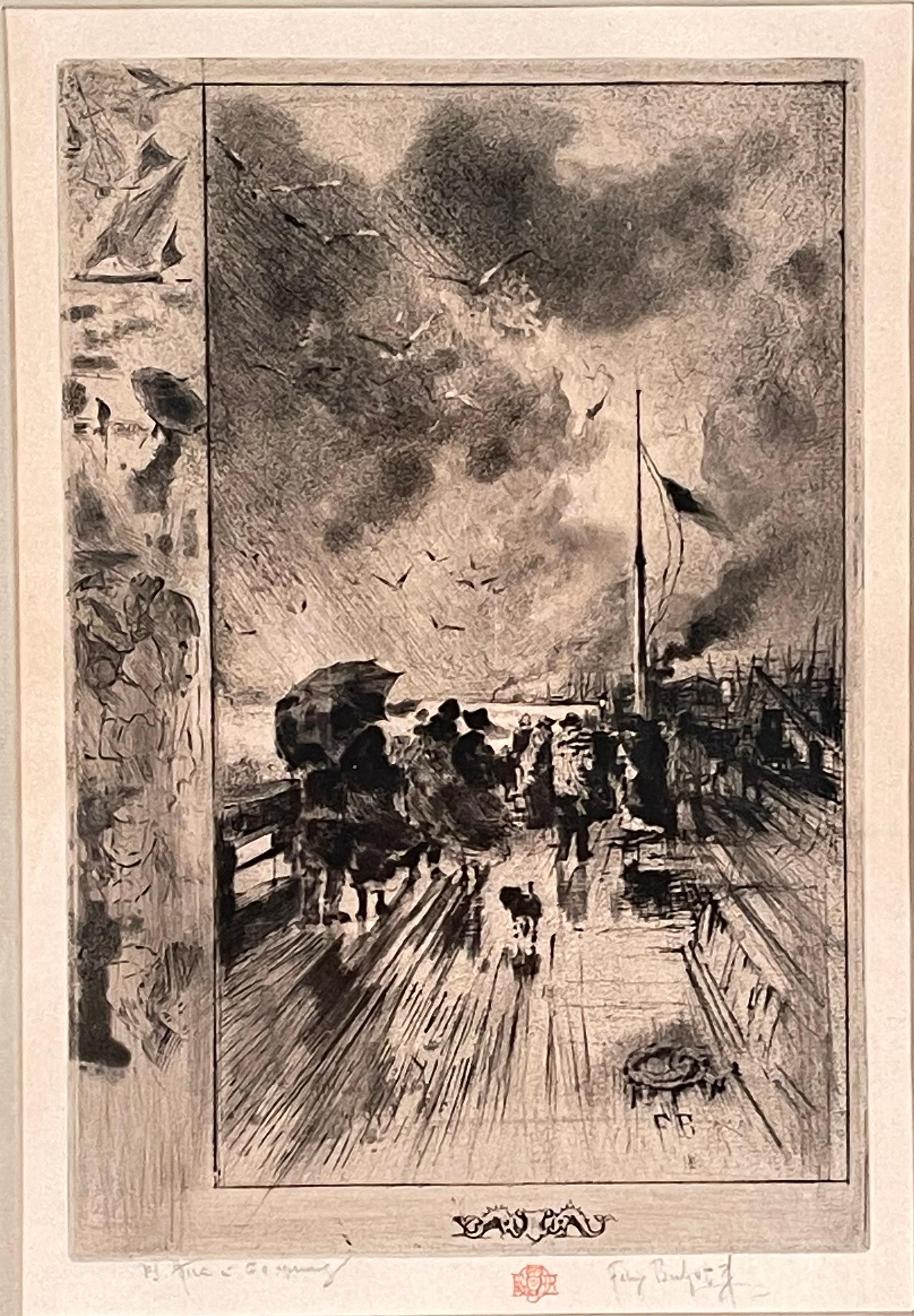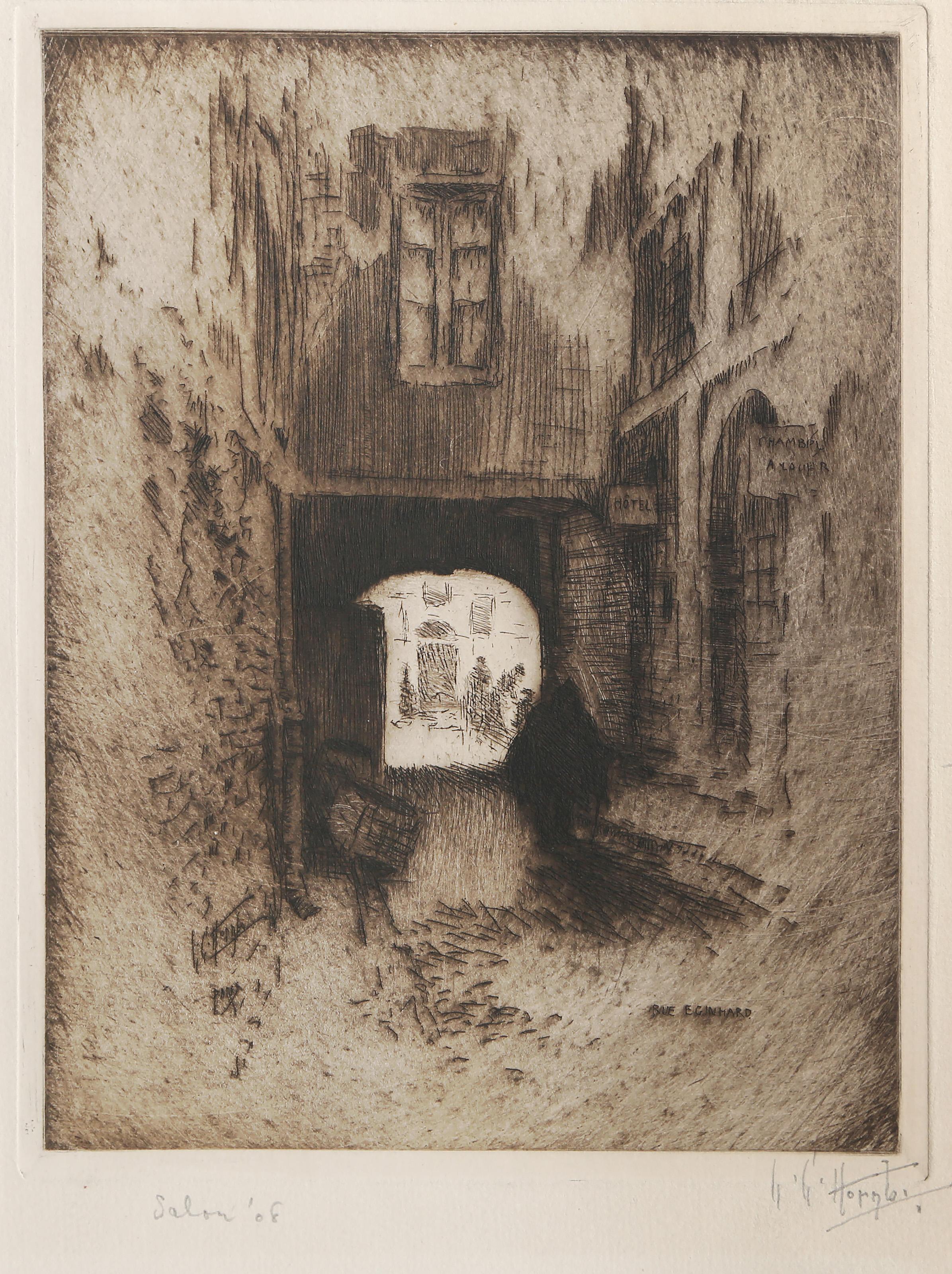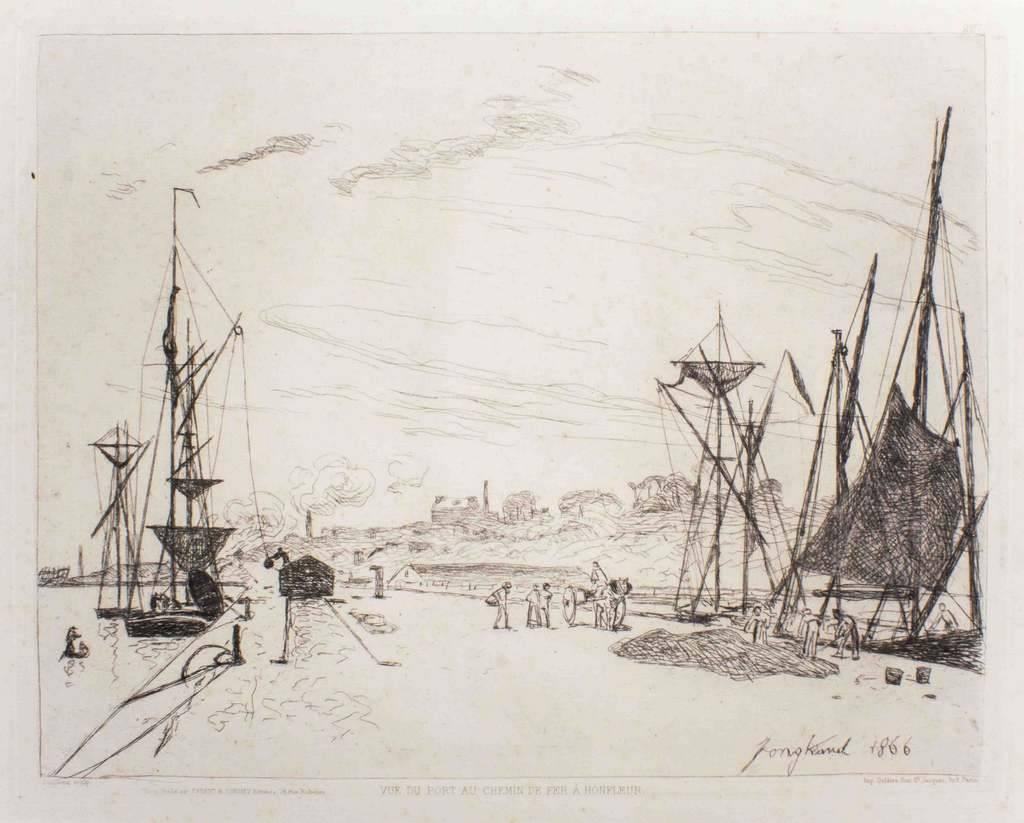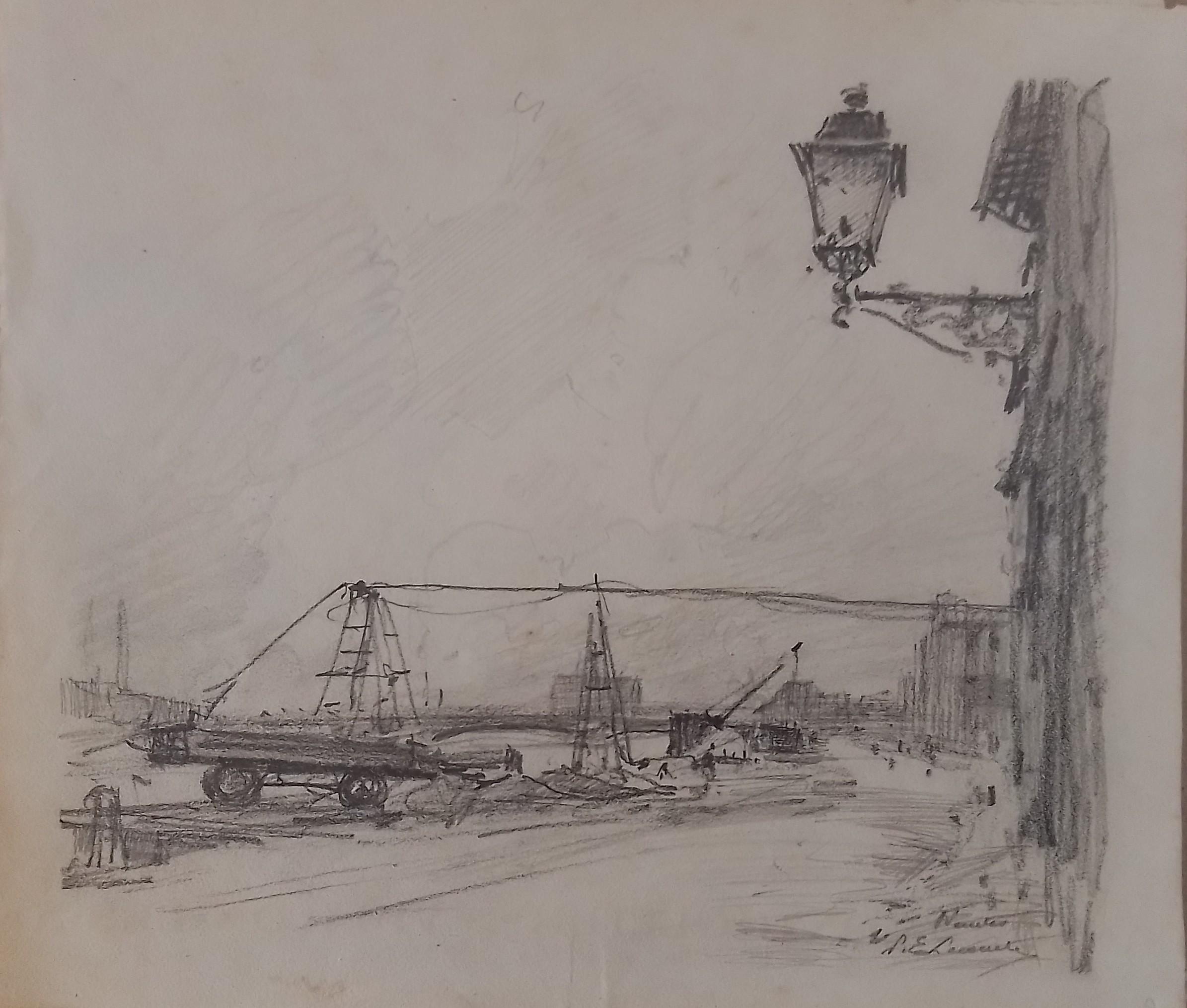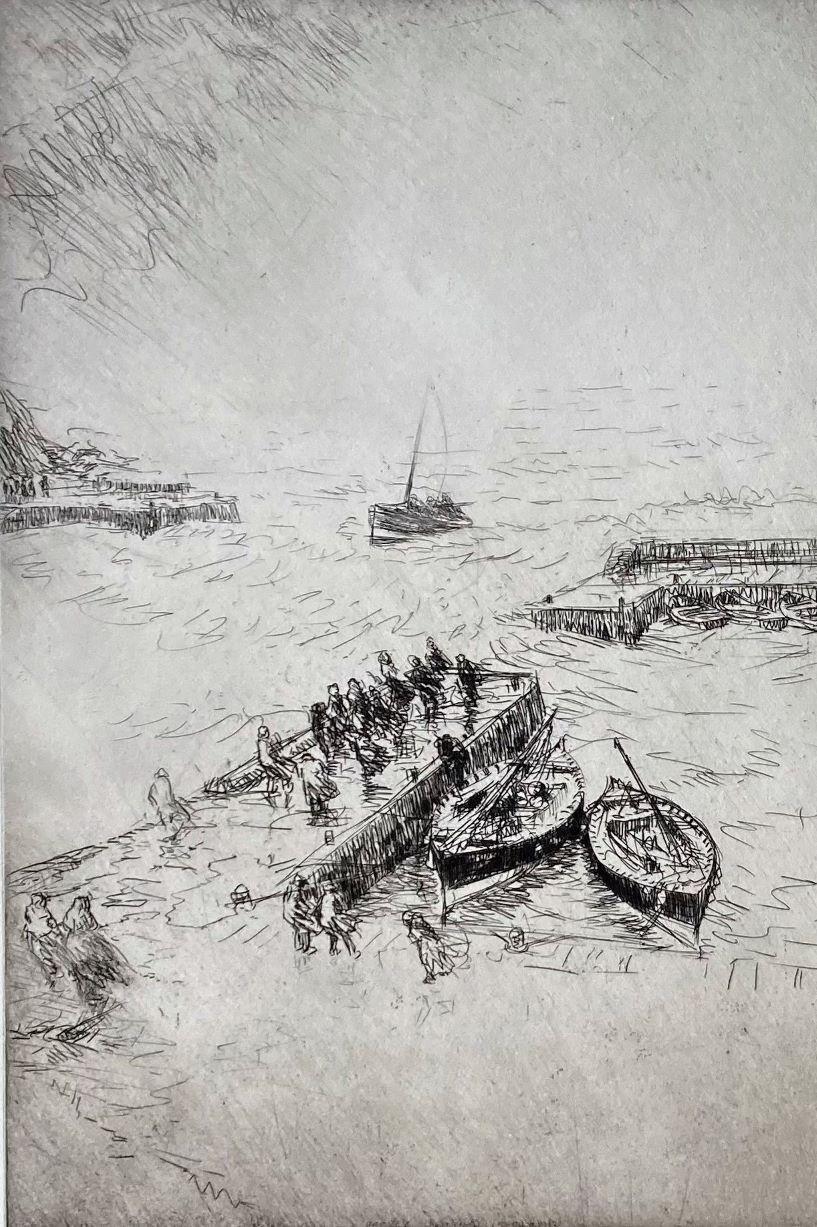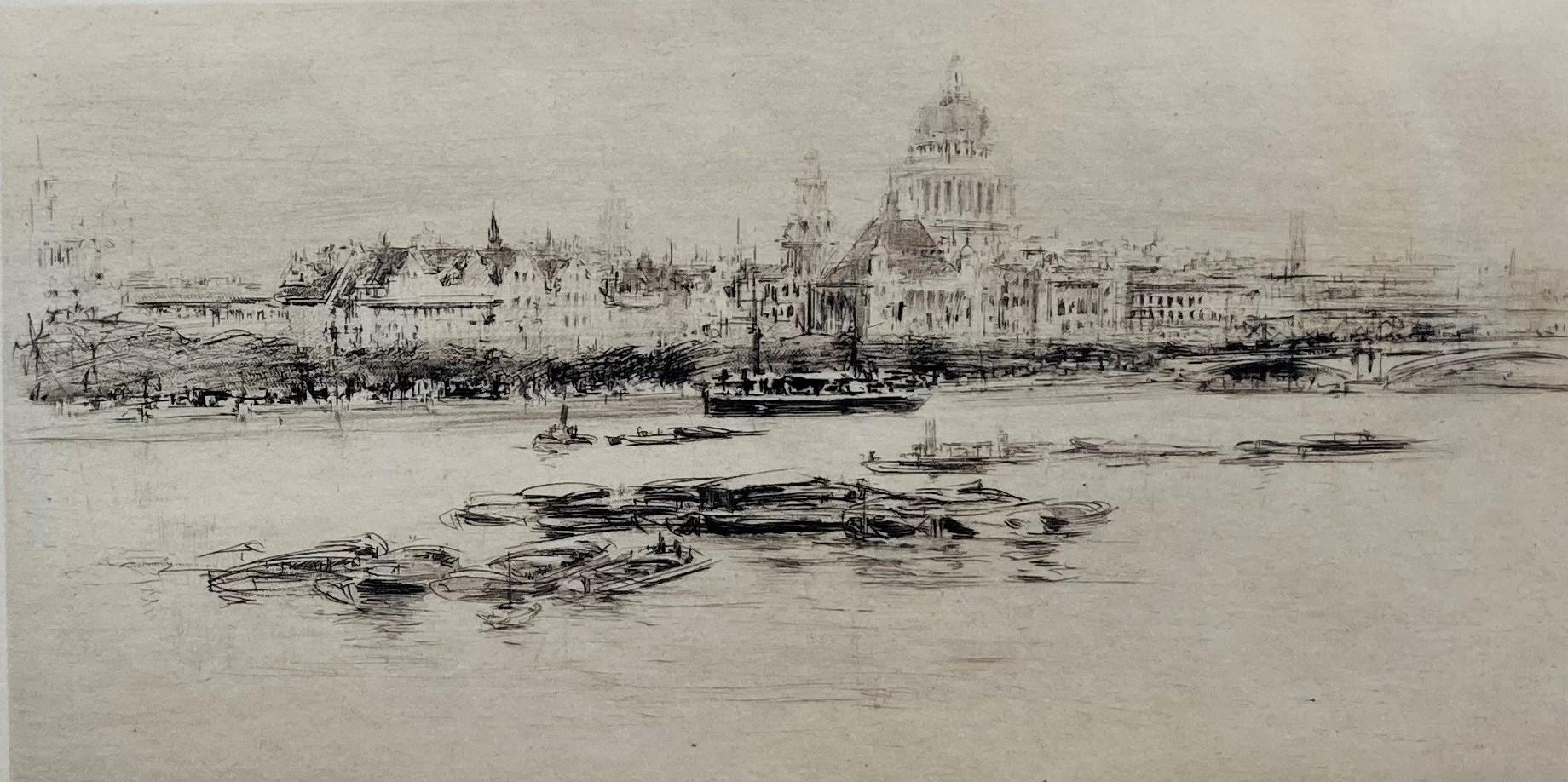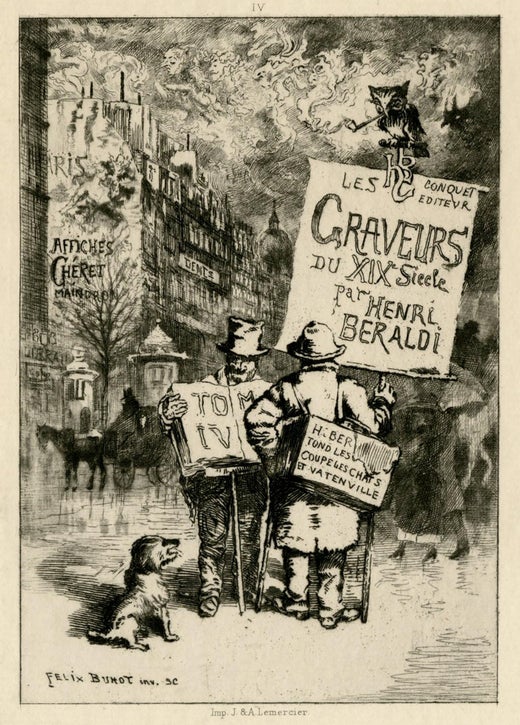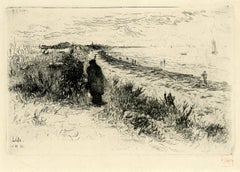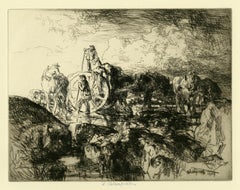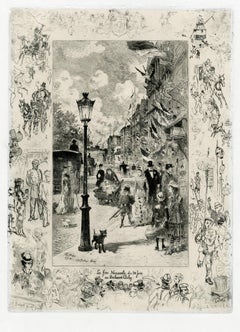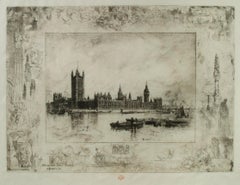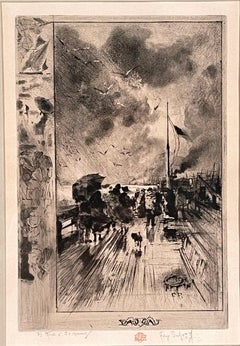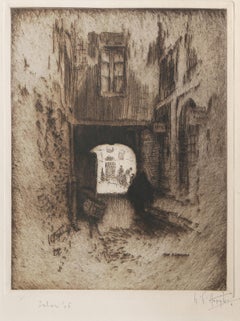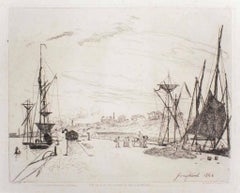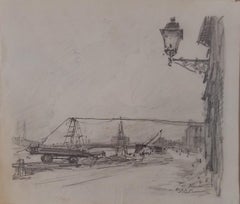Items Similar to Un Debarquement en Angleterre (A Disembarking in England)
Want more images or videos?
Request additional images or videos from the seller
1 of 6
Félix Hilaire BuhotUn Debarquement en Angleterre (A Disembarking in England)1879
1879
$4,000
£2,987.81
€3,463.89
CA$5,553.90
A$6,225.21
CHF 3,241.28
MX$76,012.44
NOK 41,152.51
SEK 39,008.88
DKK 25,844.35
Shipping
Retrieving quote...The 1stDibs Promise:
Authenticity Guarantee,
Money-Back Guarantee,
24-Hour Cancellation
About the Item
Un Debarquement en Angleterre
(A Disembarking in England)
etching, drypoint, aquatint, roulette and spirit ground, 1879
Signed with the artist’s red owl stamp, Lugt 977 (see photo)
Very rich impression with burr and selective wiping of the plate to create atmospheric effect.
Printed on a cream fibrous “oatmeal” paper
Reference: Bourcard/Goodfriend 130 v/V
Provenance: Jeffrey M. Kap;an, Washington, D.C. (label)
Archival framing with OP3 Acrylic (see photo)
Condition: Printed on an antique tan paper for atmospheric effect. Stain in upper margin outside of plate mark and matting window
Very rich impression full of burr and selective inking to created an atmospheric effect.
Félix-Hilaire Buhot
French, 1847 - 1898
Among the most original prints made in France during the last quarter of the nineteenth century are those by Félix Buhot. Born in 1847 in the small Normandy town of Valognes, in northern France, Buhot moved to Paris in 1865, where a year later he enrolled in the École des Beaux-Arts, studying painting and drawing under various artists. Buhot first learned to etch in about 1873, producing his first etching later that year and quickly establishing himself as a successful printmaker. The young artist made his living by decorating fans and illustrating lithographic sheet music. Buhot lived and worked most of his life in Paris, with frequent visits back to northern France and extended trips to England where he met his wife, Henrietta Johnston, whom he married in 1881. By 1892 Buhot had ceased making prints, and in 1898, after suffering prolonged bouts of deep depression, he died at the age of fifty-one.
Along with Edgar Degas and Camille Pissarro, Félix Buhot numbers among the most experimental printmakers of his day. In exploring the unique aspects of etching, he developed an approach to printmaking that was very painterly; in fact he called his prints "paintings on copper." A true printmaker's printmaker, Buhot delighted in all the technical variables and regularly combined multiple processes to produce a single print: he achieved even greater tonal variation by employing the more traditional techniques of etching, drypoint, and aquatint along with several less familiar methods. Unlike many contemporary printmakers who disliked photography, Buhot heartily embraced the medium and used it as a creative aid. He also used different inks and papers for varied effects. His most original contribution to the history of printmaking is a device he termed marges symphoniques (symphonic margins): by amplifying the main subject, such illustrations became an integral part of the print.
In his many prints of city views and seascapes, Buhot was intent on creating a specific atmosphere, especially the effects of weather such as rain, snow, mist, and fog. He turned to his immediate neighborhood in and around the boulevard de Clichy in Montmartre, Paris, for inspiration for his prints of everyday city life. Buhot delighted in portraying the varied street life of the vibrant capital city not only in different seasons (Winter in Paris, 1879) but also in moments of public display, from a festive holiday celebration (National Holiday on the Boulevard de Clichy, 1878) to a somber death observance (Funeral Procession on the Boulevard de Clichy, 1887). His city views also include London scenes (Westminster Palace and Westminster Bridge, both of 1884). And Buhot's love for the sea is evidenced in the many prints exploring its ever-changing atmospheric conditions and moods. Buhot's boat trips to England inspired two of his most characteristic prints, A Pier in England and Landing in England, both from 1879.
With his experimental printmaking techniques, Buhot became one of the best-known, admired, and collected printmakers of his day. He achieved success for his prints at the annual Salons between 1875 and 1886, and a number of his works were published in leading periodicals and books. He also found critical acclaim and support for his prints in the United States, especially after his first one-man exhibition organized by the New York print dealer Frederick Keppel in 1888.
Courtesy: National Gallery of Art, Washington, D. C.
- Creator:Félix Hilaire Buhot (1847 - 1898, French)
- Creation Year:1879
- Dimensions:Height: 11.875 in (30.17 cm)Width: 7 in (17.78 cm)
- Medium:
- Movement & Style:
- Period:
- Condition:Cleaned by Alan Firkser Printed on an antique tan paper for atmospheric effect. Stain in upper margin outside of plate mark and matting window Archival framing with OP3 Acrylic and metal leaf frame.
- Gallery Location:Fairlawn, OH
- Reference Number:Seller: FA109381stDibs: LU14014197302
Félix Hilaire Buhot
Buhot’s prints were made at a time of renewed interest in original printmaking (especially etching), which was rapidly becoming more popular than reproductive engraving. His etchings were singled out for praise as early as 1874 by the preeminent critic Philippe Burty, who admired the artist’s belles épreuves (beautiful proofs)— a term Burty promoted to denote rare, superbly inked impressions printed by the artist himself. By the 1880s Buhot had become one of the best-known and most collected printmakers of his day. Buhot’s renown extended well beyond his own country, and he also enjoyed critical acclaim and strong support for his prints in the United States. In 1888 the New York print dealer Frederick Keppel (1845-1912) gave Buhot his first one-man exhibition, which was quite successful. In addition to Keppel, Buhot became friends with two prominent late nineteenth-century American collectors who amassed large numbers of the artist’s prints: Samuel P. Avery (1822-1904) of New York collected over 300 prints and George A. Lucas (1824-1909) of Baltimore owned some 200 prints. Beginning in 1911, another large collection was formed by Albert H. Wiggin (1868-1951) of Boston, who bought over 150 impressions. Today, these collections can be found in, respectively, the New York Public Library, the Baltimore Museum of Art, and the Boston Public Library.
About the Seller
5.0
Recognized Seller
These prestigious sellers are industry leaders and represent the highest echelon for item quality and design.
Gold Seller
Premium sellers maintaining a 4.3+ rating and 24-hour response times
Established in 1978
1stDibs seller since 2013
796 sales on 1stDibs
Typical response time: 1 hour
Associations
International Fine Print Dealers Association
- ShippingRetrieving quote...Shipping from: Fairlawn, OH
- Return Policy
Authenticity Guarantee
In the unlikely event there’s an issue with an item’s authenticity, contact us within 1 year for a full refund. DetailsMoney-Back Guarantee
If your item is not as described, is damaged in transit, or does not arrive, contact us within 7 days for a full refund. Details24-Hour Cancellation
You have a 24-hour grace period in which to reconsider your purchase, with no questions asked.Vetted Professional Sellers
Our world-class sellers must adhere to strict standards for service and quality, maintaining the integrity of our listings.Price-Match Guarantee
If you find that a seller listed the same item for a lower price elsewhere, we’ll match it.Trusted Global Delivery
Our best-in-class carrier network provides specialized shipping options worldwide, including custom delivery.More From This Seller
View AllLido (Venice)
By Otto Henry Bacher
Located in Fairlawn, OH
Lido (Venice)
Etching on chine collee, 1880
Part of the artist's "Venice Set"
Signed upper right in plate :Otto H Bacher" (see photo)
Signed with the estate stamp, Lugt 2002 recto lower right beneath image. (see photo)
Created October 20, 1880
Reference: Andrew Venice No. 29
Provenance: Estate of the Artist
Otto H. Bacher (1856-1909)
Otto Henry Bacher was born in Cleveland, Ohio, to a family of German descent. He first studied art at the age of sixteen with local genre trompe l'oeil still-life artist, DeScott Evans. Although he studied with Evans for less than one year, Bacher's early work, comprised mainly of still lifes, betrays Evans's influence. After a short period in Philadelphia, where he studied at the Pennsylvania Academy of the Fine Arts, Bacher returned to Cleveland and met Willis Seaver Adams, an artist from Springfield, Massachusetts, who had just recently arrived upon the Cleveland art scene. Soon the two artists were rooming together. Adams was instrumental in the founding of the Cleveland Art Club, as well as the establishment of the Cleveland Academy of the Fine Arts, to the board of which Adams had Bacher appointed. Also during this time, Bacher began to learn the process of etching from local etcher and landscape painter Sion Longley Wenban.
In 1878, Bacher and Adams left for Europe. After stopping briefly in Scotland, Bacher went on to Munich, where he enrolled at the Royal Academy. He quickly tired of the rigors of the academy, and soon he was studying with Cincinnati artist Frank Duveneck, the prime American exponent of the Munich School. In 1879, Bacher made a trip to Florence with Duveneck as one of the celebrated "Duveneck Boys." Early the following year, the group proceeded to Venice, where Bacher and several other artists established studios in the Casa Jankovitz.
By this time an avid printmaker, Bacher had his etching press sent from Muni ch, and it was in his Venice studio that he taught Duveneck the rudiments of etching. Soon Bacher, Duveneck, and other members of the Duveneck circle were experimenting in printmaking. Among the group's contributions were some of the first American examples of monotypes, which they called "Bachertypes" because they were printed using Bacher's press.
It was also in Venice that Bacher met the venerable American expatriate artist, James McNeill Whistler. On learning of Bacher's press and his collection of etchings by Rembrandt, Whistler made himself a regular visitor to Bacher's studio, and he eventually took his own room in the Casa Jankovitz. Bacher spent much of the rest of 1880 with Whistler, the two artists sharing etching techniques. From Whistler, Bacher learned tone and line graduation; from Bacher, Whistler learned his etching techniques, including better ways of using the acid bath which produced less tedious and more efficient work. Bacher visited Whistler occasionally in the years that followed, and in 1908 he published With Whistler in Venice, his famous recollections of his time with the great artist.
Bacher spent the next two years traveling extensively throughout Italy, with Venice as the center of his operations, and he produced a number of important etchings of Italian subjects. Bacher sent several of these works to America in 1881 to be included in the Society of American artists exhibition that year, and had a similar group of works shown at the Royal Society of Painter-Etchers' first exhibition at the Hanover Gallery in London. Following the exhibition, Bacher, along with several other of the American contributors, was elected a Fellow of the Society. Bacher collected twelve of his etchings of Venetian subjects and sold them in bound volumes through his New York dealer, Frederick Keppel.
Bacher returned to Cleveland in January 1883 as a fully cosmopolitan artist. He set up a lavish studio furnished with exotic items and objets-d'art he had collected on his travels, and began to hold art classes as a means to supplement his income. He soon joined with Joseph De Camp in forming a summer sketch class in Richfield, Ohio. Bacher and De Camp also planned the Cleveland Room for a major loan exhibition in Detroit that year. During this period, Bacher increasingly painted in oil, and he began to produce sun-dappled canvases in an impressionistic mode.
Unable to sell any paintings from this early period, however, Bacher left Cleveland for Paris in 1885, where he planned to undertake further studies. Stopping first in London to visit Whistler, Bacher stayed only briefly in Paris before heading to Venice, where he spent the remainder of the year. In January 1886, Bacher returned to Paris and enrolled at the Académie Julian, and also entered the atelier of Emile-Auguste Carolus-Duran. The life of the student seems never to have suited Bacher, as he stayed in Paris only through June, before departing again for Venice. For the next six months he, Robert Blum, and Charles Ulrich...
Category
1880s American Impressionist Prints and Multiples
Materials
Etching
A Jersey Vraic Cart
By Edmund Blampied
Located in Fairlawn, OH
A Jersey Vraic Cart
Etching, 1939
Signed lower center margin (see photo)
Signed and dated in the plate (see photo)
Edition 250 plus 10 on J. Whatman laid paper
Printed by David Stran...
Category
1930s English School Animal Prints
Materials
Etching
La Fête Nationale du Boulevard Clichy
By Félix Hilaire Buhot
Located in Fairlawn, OH
La Fête Nationale du Boulevard Clichy
Etching, drypoint, and aquatint, 1878
Signed lower left in the plate (see photo)
Printed chine collee, mounted on white wove paper
Upper plate m...
Category
1870s French School Figurative Prints
Materials
Etching
Westminster Palace
By Félix Hilaire Buhot
Located in Fairlawn, OH
Westminster Palace
Etching, Drypoint, Aquatint, roulette and salt ground lift
1884
Depicts the Houses of Parliament, Big Ben Clock and Tower and the...
Category
1880s French School Landscape Prints
Materials
Etching
Untitled (Venice canal, man departing the gondola)
By Levon West
Located in Fairlawn, OH
Untitled (Venice canal, man departing the gondola)
Drypoint, c. 1930-1931
Signed in pencil lower right (see photo)
Annotated in the lower margin:
"Just a souvenir made ___ Monclair L...
Category
1930s American Impressionist Landscape Prints
Materials
Drypoint
La Promenade
By Edgar Chahine
Located in Fairlawn, OH
La Promenade
Etching, soft-ground, aquatint & drypoint,
Signed in pencil lower left
Published by Edmund Sagot, Paris
Edition of 50 in black only, aside from the edition of 50 in co...
Category
Early 1900s Art Nouveau Figurative Prints
Materials
Drypoint, Etching, Aquatint
You May Also Like
UNE JETEE EN ANGLETERRE
By Félix Hilaire Buhot
Located in Portland, ME
Buhot, Felix (French, 1847-1898). UNE JETEE EN ANGLETERRE. B & G 132, State two of eight. Etching with drypoint, aquatint and roulette, 1879. Signed in pencil, and with the red owl...
Category
1870s Landscape Prints
Materials
Drypoint, Etching, Aquatint
Rue Eginhard, Signed Impressionist Etching by Lester George Hornby
By Lester George Hornby
Located in Long Island City, NY
Rue Eginhard
Lester George Hornby, American (1882–1956)
Date: 1908
Etching on laid paper, signed in pencil
Image Size: 7.25 x 5.5 inches
Size: 8.75 x 6.5 in. (22.23 x 16.51 cm)
Category
Early 1900s Impressionist Landscape Prints
Materials
Etching
Vue du Port au Chemin de Fer à Honfleur
By Johan Barthold Jongkind
Located in Roma, IT
Signed on plate.
Plate: 267
Image Dimensions : 24 x 34 cm
This artwork is shipped from Italy. Under existing legislation, any artwork in Italy created over 70 years ago by an arti...
Category
1860s Impressionist Landscape Prints
Materials
Etching
Paul emile Lecomte - study of the quais by the river - pencil - signed.
By Paul Emile Lecomte
Located in PARIS, FR
Provenance: Family of the artist, studio sale. Signed in pencil lower right.
SHIPPING: Continental USA and Worldwide delivery included
Born in Paris, the French painter Paul Lecomt...
Category
Late 19th Century Impressionist Landscape Paintings
Materials
Pencil
A Gale at Port Errol
By James McBey
Located in Storrs, CT
A Gale at Port Errol. 1923. Etching. Hardie 215, #46. 13 x 8 3/4 (sheet 16 7 /8 x 11 1/2). Edition 76. #46. Illustrated: Fine Prints of the Year, 1923. A rich...
Category
1930s Modern Landscape Prints
Materials
Drypoint, Etching
$1,250 Sale Price
37% Off
The Thames from Waterloo.
By William Walcot R. E. Hon. R. I. B. A.
Located in Storrs, CT
The Thames from Waterloo Bridge. 1913. Etching. Dickins 12. 3 3/4 x 7 1/16 (sheet 7 x 10 15/16). Edition 100. A fine proof with tonal wiping, printed on cream-wove paper. Signed in pencil.
Architectural draughtsman, etcher. Born in Lustdorf, near Odessa, Russia, to a British father and Russian mother. Traveled extensively with his family before studying architecture in St Petersburg, with further studies at Ecole des Beaux-Arts and Atelier Redan, Paris. Practiced architecture in Moscow and was co-designer of the Metropole Hotel, in 1898. Moved to London in 1907 and was employed as an architectural perspectivist. After a sponsored visit to Rome and Venice he had a solo exhibit at the Fine Art Society, 1912, 'Watercolours of London and Venice'; followed by a further four shows. He also exhibited at the Royal Academy, Royal Society of British Artists, Royal Society of Painter-Etchers..., and Connell & Sons. His etchings were published in London by H C Dickens,1913-24, and a folio of his work 'Architectural watercolors and etchings of William Walcot' was published, in 1919. Elected RE, 1920; FRIBA, 1922; Associate British School at Rome. A foremost architectural draughtsman, he worked from studios in London, Oxford and Rome.
The complete set of The Arteries of Great Britain includes: The Thames, The Tyne, The Forth, The Clyde, The Mersey. Signed in pencil .Housed in a 16 x 20 inch mat suitable for framing.
Opened in 1890, the Forth Bridge...
Category
Early 20th Century Modern Landscape Prints
Materials
Etching
$620 Sale Price
20% Off
More Ways To Browse
Antique England Etching
Owl Plate
Antique Etched Windows
Palace Of Westminster
Westminster Palace
Antique Copper Window
Antique Owl Print
Funeral Procession
Antique French Aquatint Print
Copper Owls
Degas Aquatint
Felix Buhot
Antique Owl Painting
Frederick Johnston
Alfredo Muller
Altman Central Park
Banksy Walled Off Hotel
Bernard Buffet Notre Dame
